|
The small spout rose up after the large one,
straight in front of
our sea kayak. "Wow!" we shouted, our paddles raised. "Yes!�"said our guide, Scotty, a veteran of Kelli's Kayak and Snorkeling
Tours, "Mother and calf are enjoying themselves in these splendid
morning waters!" It wasn't long before the two cavorters rose to
the surface and flipped their tails in descent. It was as if they
were showing their pride at being humpbacks, old and new, in Maui's
sea paradise.
After paddling along the coast and enjoying
several more humpback
sightings we anchored our kayaks at a depth of 25 feet and snorkeled
a good section of the huge Coral Gardens reef off Maui's southwestern
shore. We saw at least thirty varieties of colorful reef fish, an
impressive array of coral, and two huge green turtles who swam close
before deciding to avoid us.
Our morning kayaking and snorkeling tour was the
perfect cap to an
incredible winter week in western Maui. We had sighted humpbacks from
the shore and green turtles while snorkeling each day of our trip. We
promised, as we had for fifteen years, to return next winter for one
of nature's best shows. The fact that Maui's temperature range from
68 to 84 degrees with temperate snorkeling waters made it easy to
visit in winter.
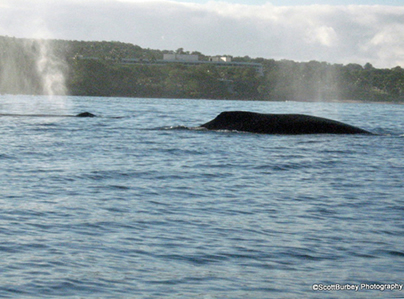 ии ии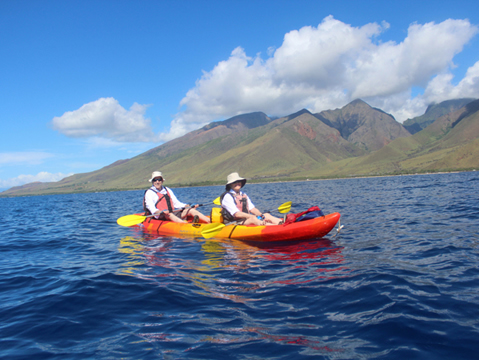
Spouting Mother and Calf
Humpbacks
Paddling Maui's
Coral Gardens Reef
The Start of It All— Maui's
Unique Geology
Humpbacks
return annually to their preferred water off of Maui's west coast.
The waters stretch between the islands of Maui, Molokai, Lanai, and
Kaho'olawe, and extend southwest past Molokai. In 1992, Congress
recognized the importance of this habitat and designated this
critical area as The Hawaiian Islands Humpback Whale National Marine
Sanctuary. The geology of this area has made it special for the
humpbacks. The critical factor, besides the desired warm water for
birthing their relatively fat-free and small calves, is the
protection afforded by the low-depth ocean floor. Sharks and other
predators of young humpbacks avoid this shallow region that averages
but 200-300 feet depth. Its geologic history traces back two million
years to a single island, Maui Nui. At that time its size was
one-and-a-half times the size of today's island of Hawaii. Over the
millenia, Maui Nui and its seven volcanoes eroded. The sea rose and
today's group of four islands with a vast low-depth shelf is the
result.
Honor the
Humpback—No Krill, No Eat
Humpbacks
are one of several "whalebone" species. They have a mouth
structure that has two rows of plates (whalebone), 2 feet to 12 feet
long, attached to their upper jaw, used for harvesting krill. The
krill are planktonic crustaceans and larvae found in their home seas
of southern Alaska. When krill are not available during the humpback
migration and at their winter home near Maui the whales do not eat.
They live off their own fat reserves. The females remain in Alaskan
waters longer than their mates to better enable them to provide milk
during their long period away from Alaska. Although variable,
the Hawaiian whale season is generally December to April. The
newborn
calves must await their journey to Alaskan seas with their mothers
before their first krill meal.
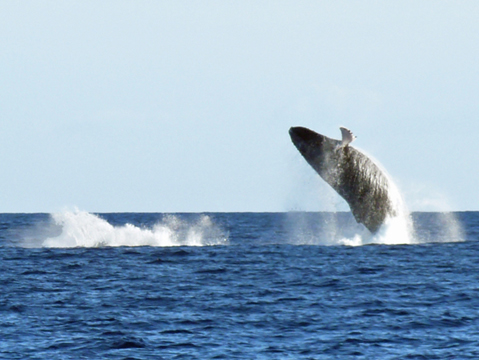 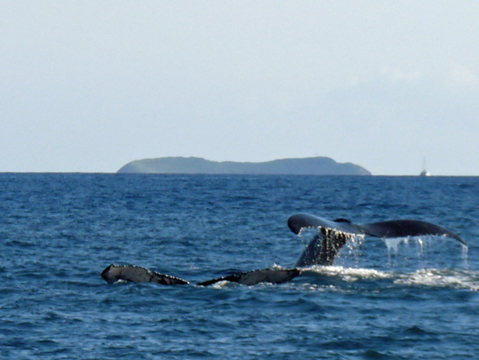
Breaching Humpback
What Goes Up Must Come Down
Humpback
migration to or from Hawaii requires 6-8 weeks for the 3,100 miles.
The whale's mating and gestation cycles are still unknown, but the
number of females is roughly half that of males. Although
both sexes produce a wide variety of sounds, only the male actually
"sings.�" The
population has increased in recent decades, but the humpback is still
on the Federal protected species list due to its depletion by the
whaling industry in the 1800s-1900s.
Go
Swim to See the Green Sea Turtle
Hundreds
of years ago, millions of sea turtles swam the Earth's oceans. Today,
all seven species of sea turtle are threatened, including Hawaii's
most common, the green sea turtle, or "homu." They pre-date many
dinosaurs and are mythological symbols of creation, longevity, and
wisdom.The green sea turtle, often seen by snorkelers or divers along
Maui's western shore, is a gentle vegetarian reptile that weighs up
to 400 pounds and feeds on coral reef algae and seaweed.
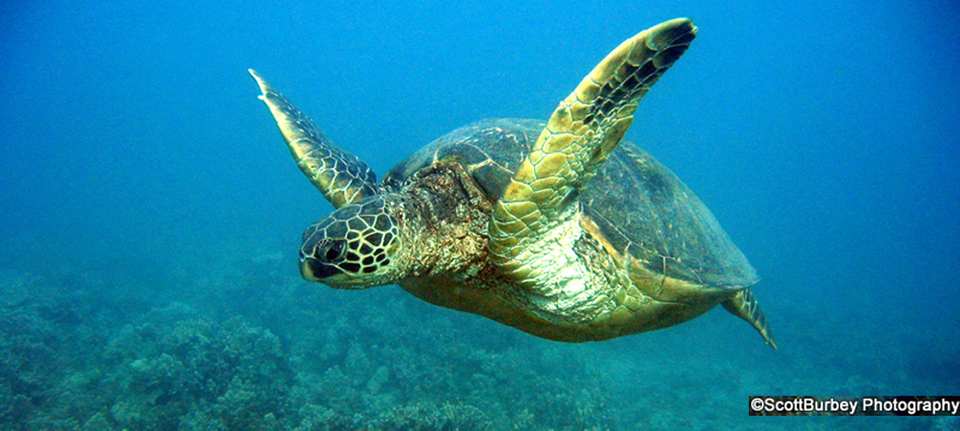
Green Sea Turtle or Homu Heads Home
Hawaii's
green sea turtles migrate 800 miles from their feeding areas to
nesting beaches in the Northwestern Hawaiian Islands. Males accompany
the females in this migration and mate with them offshore before the
females
come ashore to nest. Females
return to the beach of their birth 35 to 40 years later to lay eggs
for the next generation. Despite laying hundreds of eggs, only a few
hatchlings survive to maturity. Hatchlings live in the open ocean for
several years, feeding on jellyfish, until they've grown to a point
where they can join adult turtles at the vegetarian coastal feeding
grounds.
The
two major enemies of these creatures are tiger sharks in the open
ocean and divers and snorkelers in their feeding grounds. Enjoy the
sight of a sea turtle while in the reef waters of Maui, but avoid
getting closer than several feet. If a turtle "yawns" with open
mouth, swipes its flipper, or dives suddently, it is indicating
you've violated its safe space.
Remember
Those Reefs
Mau's
western shore is blessed with the islands' most pleasant beaches, most
of which also provide access to reefs full of sea life. We snorkled
half of our days at our favorite beach and reef, Kapalua, and also
mixed in snorkeling and beach stays at Napili Beach, just south of
Kapalua, and Mile Marker 14. The day that we took Kelli's Kayak and
Snorkeling Tour to the Coral Gardens' expansive reef, we enjoyed an
afternoon in the village of Lahaina with its restaurants, coffee
shops, and taverns. Every day we were able to view whales, swim with
turtles and enjoy the coral and sea life of the reefs. Our favorite
fish spottings included the racoon butterfly fish, Christmas wrasse
and cleaner wrasse, blue-spine unicornfish, white spotted toby,
Moorish idol, and yellow tang. The beautiful array of these and other
sea creatures was mind-boggling.
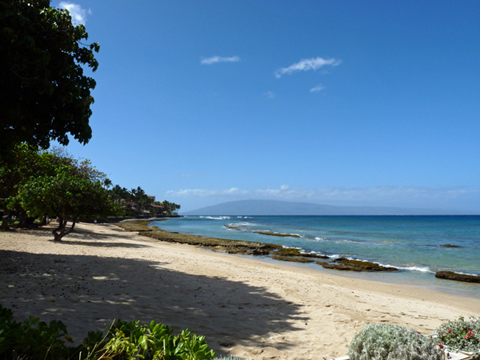 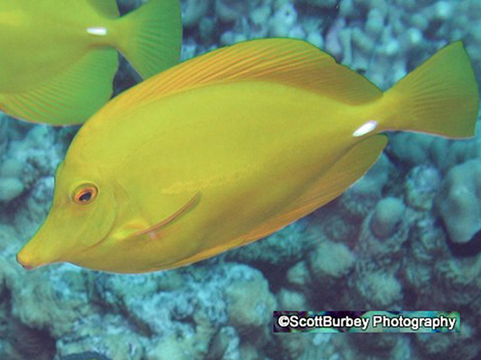 Beach
& Reef
Yellow Tang Beach
& Reef
Yellow Tang
We
think of those reefs throughout the year as we await our return to
Maui's incredible environment. Will we again be as fortunate to see
whales and green sea turtles each day of our next week-long vacation?
When
You Go
Air/Car/Lodging/Dining
Standard
Web searches easily provide needed information for flights, car
rentals, lodging alternatives, and dining. Use Googles maps for the
west coast of Maui, and locate the communities of Lahaina, Kaanapali,
Kahana, and Kapalua. They provide a broad a range of lodging and
dining options.
Best
snorkeling beaches
Maui's
west coast provides the best array of snorkeling beaches. From south
to north on the western isalnd some good spots are Mile Marker 14,
Black Rock (Kaanapali) Napili, and Kapalua.
Sporting
Equipment, Tours, Etc.
Snorkeling
equipment can be rented at a number of Snorkel Bob's locations that
are convenient to all the major lodging establishments. They also
rent bicycles, surfboards, and other equipment. Snorkel
Bob's provides access to a number of whale-watching tour
opportunities,
including the "Kayak and Snorkel" tour mentioned in this article.
Other whale watching tour opportunities are available in Lahaina and
at Maalaea Harbor.
Sea
kayaks can be rented for the week from Maui Ocean Rentals, by owner
Scott Burbey. He is also available as photographer, and provided
several of the photographs in this article.
About
the Authors
Les
and Rita Furnanz originated High on Adventure magazine in April 1997
and were active writing partners until February 2004. On occasion
they continue to contribute HOA articles. They visit France, Germany,
and Hawaii every year and other world locations from time to time.
They are still saying, "Yes... we are High on Adventure!�"
|